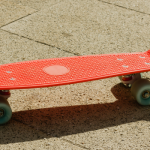When it comes to skateboarding, there is often a debate about wearing helmets. Some argue that helmets are necessary for safety while others believe they hinder their performance and style. So, do skateboarders really wear helmets?
The answer is yes and no. It ultimately depends on the individual’s personal choice and the type of skating they are doing.
In this article, we will explore the reasons why skateboarders choose to wear helmets and why some do not. We will also discuss the importance of prioritizing safety while participating in any sport.
Importance of safety in skateboarding
Skateboarding is a high-risk sport that involves performing tricks and stunts on a board. With such extreme movements and potential falls, it is crucial to prioritize safety while skateboarding.
According to the Centers for Disease Control and Prevention (CDC), skateboarding is one of the top activities associated with traumatic brain injuries in children and adolescents. These injuries can have serious long-term consequences, making it essential for skateboarders to take necessary precautions.
Safety Tip 1: Wear a Helmet
Importance: Protecting your head is paramount, considering the potential severity of head injuries.
How Helmets Help:
Helmets act as a crucial line of defense by absorbing impact energy, reducing the risk of concussions or skull fractures.
Choosing a Helmet:
- Opt for a certified skateboard helmet designed for impact protection.
- Ensure a snug fit without being overly tight or loose.
- Always fasten the chin strap securely to keep the helmet in place during falls.
Safety Tip 2: Use Protective Gear
Overview:
Beyond helmets, knee and elbow pads are essential for additional protection, particularly for vulnerable joints.
Reducing Severity:
Protective gear minimizes the severity of injuries, preventing cuts, scrapes, and fractures.
Comprehensive Approach:
- Consider wrist guards to safeguard against fractures and sprains.
- Invest in high-quality protective gear and wear it consistently for all skateboarding sessions.
Safety Tip 3: Learn and Master Basic Skills
Importance: Fundamental skateboarding skills lay the groundwork for safe and controlled riding.
Contributions to Safety:
Basic skills improve balance, stability, and overall control on the skateboard, enhancing the ability to navigate obstacles and challenging terrain.
Practice Techniques:
- Dedicate time to practicing basic maneuvers like pushing, turning, and stopping.
- Gradually progress to more advanced tricks as your skills develop.
Safety Tip 4: Choose Appropriate Skateboarding Locations
Guidance on Locations:
- Select Safe Areas: Choose skateboarding locations designated and safe for riding.
- Avoid Hazards: Be aware of potential hazards such as uneven surfaces, traffic, or crowded pedestrian areas.
Identifying Hazards:
- Scan the area for cracks, debris, or obstacles that may pose a threat.
- Follow local regulations and guidelines regarding skateboarding locations.
Safety Tip 5: Be Mindful of Surroundings
Situational Awareness:
- Stay alert to your surroundings, including pedestrians, cyclists, and other skaters.
- Be cautious of traffic and adhere to road safety rules if skating in urban areas.
Obstacle Recognition:
- Anticipate potential obstacles and adjust your speed and trajectory accordingly.
- Use peripheral vision to stay aware of what’s happening around you.
Respecting the Environment:
- Avoid damaging public or private property, and be respectful to the community.
- Follow any posted rules or regulations in the skateboarding area.
Reasons for wearing helmets
Now that we’ve established the importance of safety in skateboarding, let’s dive into why some skateboarders choose to wear helmets.
Head Injury Prevention:
- Helmets serve as a vital protective layer, absorbing impact energy and reducing the severity of head injuries during falls or collisions.
- They significantly decrease the risk of concussions, skull fractures, and traumatic brain injuries, which are common in skateboarding accidents.
Legal Compliance:
- Many jurisdictions have laws mandating the use of helmets while engaging in activities like skateboarding.
- Adhering to these regulations is not only a legal requirement but also helps avoid fines and penalties.
Safety Culture:
- Wearing a helmet fosters a safety-conscious culture within the skateboarding community.
- It sets a positive example for others, encouraging responsible behavior and contributing to an environment that prioritizes well-being.
Impact Visibility:
- Helmets are often brightly colored or equipped with reflective elements, increasing the skateboarder’s visibility to others.
- This enhanced visibility is crucial for safety, especially in areas with traffic or when sharing spaces with pedestrians and cyclists.
Protection from Debris and Weather:
- Helmets shield skateboarders from potential hazards such as debris, insects, or adverse weather conditions.
- This protection ensures a distraction-free and comfortable experience, allowing skateboarders to focus on their skills.
Insurance Compliance:
- Some skate parks, events, or organized competitions may have insurance requirements that mandate participants to wear helmets.
- Complying with these requirements is essential to ensuring the safety of all participants and maintaining liability coverage for the organizers.
Comprehensive Safety Gear:
- Helmets are a fundamental part of a complete safety gear ensemble that may include knee and elbow pads, wrist guards, and other protective equipment.
- Wearing a helmet promotes the use of a comprehensive safety setup, reducing the overall risk of injury.
Promotion of Responsible Riding:
- Wearing a helmet is a responsible choice that demonstrates a commitment to personal safety and the safety of others.
- It reinforces the idea that safety precautions are an integral part of skateboarding, contributing to a positive and responsible skateboarding culture.
Peace of Mind:
- Both skateboarders and their families gain peace of mind knowing that adequate safety measures, including helmets, are in place.
- This sense of security allows individuals to enjoy skateboarding with confidence and reduces concerns about potential injuries.
So, Do you need a helmet on a skateboard?
Absolutely, wearing a helmet is crucial for the safety and well-being of skateboarders.
Not only does it protect against head injuries, but it also sets a positive example, promotes a safety-conscious culture, and provides peace of mind for both skateboarders and their loved ones.
So, whenever you hop on your skateboard, remember to always wear a helmet and other protective gear for a fun and safe experience.
Conclusion
We hope this guide has emphasized the importance of safety in skateboarding and provided valuable insights into why helmets are an essential part of skateboarding equipment. Remember to follow the safety tips outlined, practice basic skills, and choose appropriate locations for skating. By doing so, you can enjoy the thrill of skateboarding while keeping yourself and others safe. So go out there, have fun, and skate responsibly.
![Why do skateboarders hate scooters? [Reasons + Tips] Why do skateboarders hate scooters? [Reasons + Tips]](https://bedoper.site/wp-content/uploads/2023/04/Why-do-skateboarders-hate-scooters-150x150.png)


![How fast do skateboards go downhill? [90 mph (145 km/h)] How fast do skateboards go downhill? [90 mph (145 km/h)]](https://bedoper.site/wp-content/uploads/2023/04/How-fast-do-skateboards-go-downhill-150x150.png)
